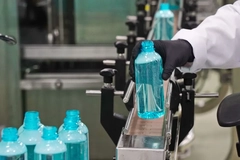Ethical packaging revolution: Kosé creative director unravels aesthetics-sustainability connection in cosmetics

24 May 2023 --- In today’s competitive landscape influenced by a growing number of socially conscious consumers, how can cosmetics packaging effectively integrate functionality and ethical considerations while aligning with a brand’s image? We pose this question to Henri Harada, chief creative director of packaging design at Kosé Corporation’s Product Designing department.
Harada illustrates that companies are increasingly expected to demonstrate social responsibility, placing the charge on packaging designers to create visually appealing designs that integrate ethical practices seamlessly, all while upholding the brand’s value.
“In general, packaging is the first point of contact with the customer and has a large impact because it determines the impression of whether or not a quality experience can be had and whether or not a sense of security can be maintained,” he tells PackagingInsights.
According to Harada, it is crucial for customers to perceive a sense of ethics through packaging. He cites an example from Kosé’s Sekkisei Clear Wellness product, where it has consciously utilized corrugated cardboard for the outer packaging and paper material for the outer bag. This deliberate choice allows customers to recognize the ethical nature of the packaging itself easily.
Striking a delicate balance between aesthetics and ethics is a challenge. Harada acknowledges the difficulties of incorporating sustainable practices without compromising the brand’s perceived value.
 Bottles in the Kosé’s Sekkisei Clear Wellness line are refillable and made from bio-based PET.As an illustration, he points to the use of recycled materials in packaging. Harada notes that if recycled material is colored and has inherent limitations in terms of available quantity and matching the product’s contents, it may no longer be suitable for packaging purposes.
Bottles in the Kosé’s Sekkisei Clear Wellness line are refillable and made from bio-based PET.As an illustration, he points to the use of recycled materials in packaging. Harada notes that if recycled material is colored and has inherent limitations in terms of available quantity and matching the product’s contents, it may no longer be suitable for packaging purposes.
“It is important for a brand to maintain consistent quality and a worldview and convey this in its packaging,” he says.
Diverse global consumer needs
Kosé, established by Kozaburo Kobayashi in Japan in 1946, has grown into a global enterprise that delivers high-quality skin care, makeup, fragrance, body and hair care products.
With a workforce exceeding 14,015 employees, the company’s commitment to research and innovation has led to the acquisition of over 800 registered patents. Kosé holds an extensive portfolio of 37 brands, including renowned names such as Decorté, Tarte, Jill Stuart, Sekkisei, Esprique and One By Kosé.
“Our policy is to offer original and valuable products in all of our brand categories, particularly in the high-prestige and prestige brands, which are characterized by high added value, and the cosmetaries [cosmetics and toiletries] brands, which offer inexpensive and affordable products, mainly in the self-service category,” explains Kosé.
When choosing packaging that balances consumer appeal with environmental sustainability and hygiene, Harada underscores the company’s commitment to raising awareness of ethicality.  Sekkisei product outer packaging is made from a minimum of 90% recycled-in-Japan cardboard.
Sekkisei product outer packaging is made from a minimum of 90% recycled-in-Japan cardboard.
“It is important to choose ethically sourced materials while taking into account their marketability, which is linked to the culture of the area where the brand operates and assuming that it will not diverge from the biggest trends and movements,” he explains.
Harada argues that if there is a divergence from sustainability in the market, it is crucial to bridge that gap and promote ethical packaging. “As a designer, I would be happy if the continued use of paper materials, such as corrugated cardboard and biomass PET in the Sekkisei Clear Wellness skin care line, changes customers’ awareness and makes them choose the brand because it is ethical,” he stresses.
Harada continues to embrace this challenge, believing that fostering such awareness is essential for the industry.
Material compatibility and luxury appeal
When selecting materials for cosmetics packaging, Harada flags the scrutiny required to deliver compatibility with the product contents. “We focus on selecting hygienic materials and that we can guarantee the quality of the contents and materials will not change or deteriorate,” he says.
Beyond materials, the company considers ways to enhance the ethicality of product usage, including ease of disposal for end consumers.
 Henri Harada, chief creative director of packaging design at Kosé Corporation’s Product Designing department.Harada also highlights the importance of cosmetics packaging design in creating an uplifting customer experience, explaining that a design that exudes luxury – even when made from more ethical materials like recycled plastic – can instill positive preconceived consumer notions.
Henri Harada, chief creative director of packaging design at Kosé Corporation’s Product Designing department.Harada also highlights the importance of cosmetics packaging design in creating an uplifting customer experience, explaining that a design that exudes luxury – even when made from more ethical materials like recycled plastic – can instill positive preconceived consumer notions.
“We believe that a design with a luxurious feel appropriate for high-quality contents will lead to a sense of satisfaction as if the product’s efficacy is guaranteed,” he adds.
Packaging’s “hot topics”
Harada notes the increasing popularity of recycled glass and other recycled materials, mixed ceramics, metals, shells and heavy products with metal parts as environmentally friendly material options for cosmetics packaging.
Additionally, he says the focus has shifted from biomass plastics toward recycled resin for the material selection of plastic containers. “Both these plastics are environmentally friendly. Biomass plastics were the trend a few years ago, but recently recycled resin has become a hot topic, and we are in the process of confirming its safety,” he says.
“Items that incorporate waste materials are also a hot topic, and not limited to the cosmetics industry. We are also working on an initiative to mix used makeup materials with plastic and reincarnate them into something else.”
By Radhika Sikaria











